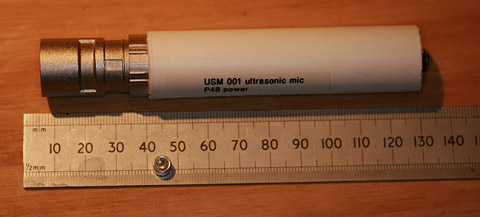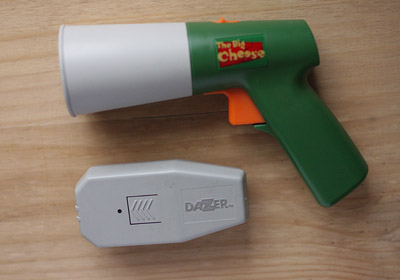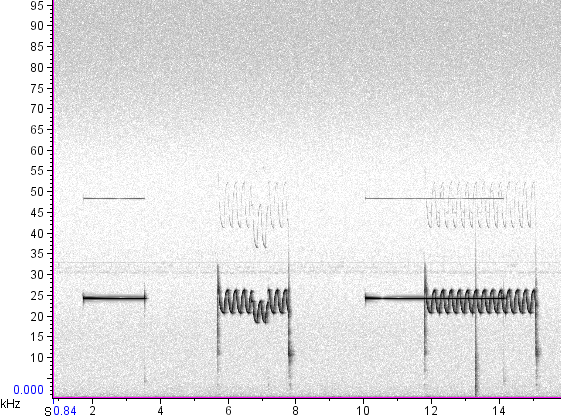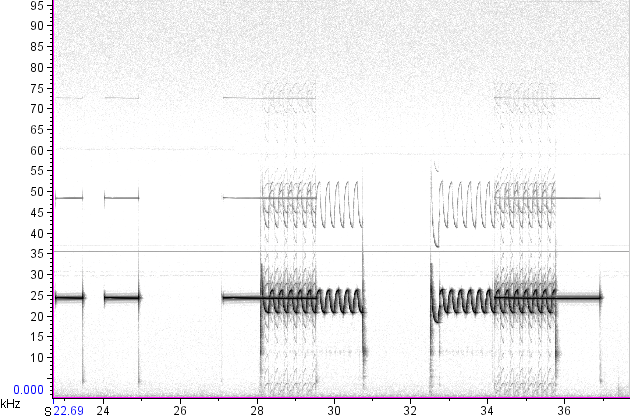A low-cost approach to recording ultrasonic vocalisations
Human hearing is generally considered to extend between 20Hz and 20kHz, though the upper range varies considerably, depending on the ravages of time and the previous exposure to loud sounds both industrial and recreational. Audio equipment is therefore targeted to this frequency range, and until recently the engineering challenges of extending the range meant that recorders in particular would perform only up to about 22kHz.
The new breed of solid state recorders, and the pressures of marketing departments mean that as the engineering constraints were lifted by more storage capacity and faster analogue to digital conversion, specmanship brought us recorders capable to recording a wider frequency range. There seems to be some anecdotal observations that extending the recorded frequency range up to 48 kHz by doubling the common sampling rate of 48kHz to 96kHz may give some audible benefits under rare circumstances because the steep filters that were needed at the edge of the audio band now only cut in an octave higher. But the most common criticism of high sampling rates was that they burn through storage medium at a higher rate, and for what good? "great for the bats" some cynics say...
But wait a moment. We are wildlife sound recordists, and it is exceedingly anthropomorphic to say that if a vocalisation lies outside our human hearing range then it is not sound. Let us record these sounds. It is not just bats that use frequencies above 20kHz - many mammals other than bats, such as rodents including rats, mice and squirrels vocalise in the 20kHz to 60kHz region. Some insects generate sounds by stridulation that extend into the ultrasonic range.
So now that we have the recorders that can stretch to the extra octave or two above 20kHz, we need microphones that are capable of the same. Of course, we could go out and buy a Sennheiser MKH800 or one of the 8000 series mics, specified all the way up to 50kHz. But that would not be low cost....

my ultrasonic microphone, adapted for P48 power
A couple of years ago, a manufacturer of bat detectors started using cheap electret microphones in some budget detectors, presumably after finding out that some capsules had a useful response up to about 60kHz. One of these capsules is the Panasonic WM61A which features in the WSRS low cost microphone design article. If you have constructed that, you are already there - go in search of bats!Technical results
I used a WM61A capsule in a phantom powered circuit with a Sound devices 702 set to 192kHz sampling rate. To try and get some qualitative indication of the frequency response, I used a proprietary "Dog Dazer" and a Maplin Electronics "Big Cheese" ultrasonic devices.

Big Cheese and Dog Dazer ultrasonic noisemakers
The original use for these devices is to make a prodigious ultrasonic racket to expel invading cats from my garden and stop them harassing birds on the feeder. This gets attention from the cats without troubling the birds or the neighbours. These were pressed into service as test sources. I was particularly interested that the WM61A showed a second harmonic in the 40-50kHz region, since this is of interest for many bat species as well as rodent vocalisations. If the mic had a response here it would be useful for ultrasonic signals. Of course the frequency response will be uneven, if you demand flatness of response then Sennheiser will be prepared to lighten your wallet. For the less well-heeled trying to spend only £1.50, some loss of accuracy is to be expected. However, another explanation for the second harmonic would be distortion in the mic. An experiment was crafted that would show which case was true.

Spectrogram - first of the Dog Dazer on its own, then the Big Cheese on its own, then the two combines
In the spectrogram you can see that the "Dog Dazer" puts out a tone at about 24kHz, and there is a second harmonic present at about 48kHz. The "Big Cheese" puts out a warbling tone which is probably designed to go between 22kHz and 26kHz. Second harmonics are present on both. I then ran both tone sources together. If the second harmonic was due to the mic, I would expect mixing products to appear. This was easily induced by aiming the devices at the mic from 2m away - these things are designed to generate a prodigious racket for our furry friends.

Spectrogram showing mixing; the modulation of "Big Cheese" is impressed upon the carrier of "Dog Dazer"
Since the first test did not show significant mixing products, the harmonics seem to be in the tone sources, and the fact that the mic shows them indicates that the mic has a useful response up to at least about 60kHz.
Not all cheap electret capsules are created equal. It is worth noting that the high-frequency performance seems to be specific to the WM61A so it should not be substituted. Swapping the mic capsule for a Rapid Electronics 35-0190 as used in this project showed no second harmonic at the levels used for the first spectrogram above.
Conclusion
If the WM61A is good enough for bat detectors, it is good enough for sound recordists on the cheap. There are no guarantees as to frequency response which is unspecified at ultrasonic frequencies, but it appears to work in practice. Of course, to capture ultrasonic frequencies you have to be recording sampling at 192kHz ideally, since many species vocalise up to 60kHz, which is too high for a recorder running at 96kHz. The highest recordable frequency is half the sampling rate. At 96kHz the highest frequency would the 48kHz whereas at 192kHz the highest recordable frequency is 96kHz, which is probably above the useful response range of the WM61A. Even with a sampling rate of 96kHz, however, much of the stridulation of insects will be in the recorded frequency range.
Specialised microphones need to be used to get greater flatness or a higher frequency response. However, most common bats - pipistrelles, noctules, serotines and Daubenton's bats, should be within the range of the WM61A and a 192kHz recorder, so this technique is worth trying in the bat season.
Recording sounds you cannot hear is of course a challenge - either watch the level meters (particularly with bats, they are very loud!) or use a bat detector to find the sound source first, though beware that bat detectors tend to interfere with the recording if run simultaneously if you are not careful. For processing, either use spectrograms, or simply change the sampling rate of the 192kHz file to 19.2kHz - which will have the effect of slowing down the recording by 10 times, easily within human hearing range.
To hear what time-expanded bats sound like, visit this page.